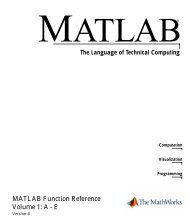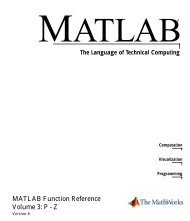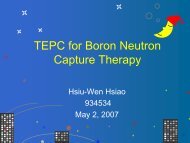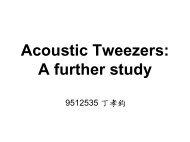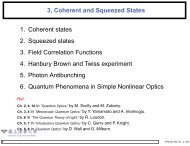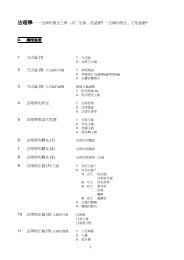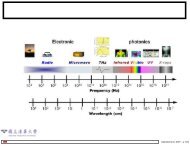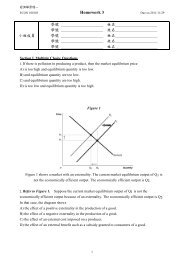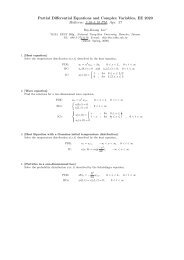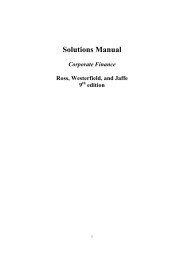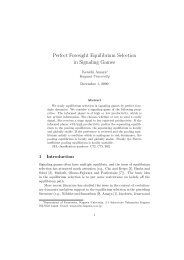Quantum Optics
Quantum Optics
Quantum Optics
You also want an ePaper? Increase the reach of your titles
YUMPU automatically turns print PDFs into web optimized ePapers that Google loves.
IPT 5340 (PHYS 6840)<br />
<strong>Quantum</strong> <strong>Optics</strong><br />
Ray-Kuang Lee †<br />
Institute of Photonics Technologies<br />
Department of Electrical Engineering and Department of Physics<br />
National Tsing-Hua University, Hsinchu, Taiwan<br />
Course info: http://mx.nthu.edu.tw/∼rklee<br />
†Ext: 42439<br />
Room 523, EECS bldg.<br />
e-mail: rklee@ee.nthu.edu.tw<br />
IPT5340, Fall ’06 – p. 1/5
IPT 5340 (PHYS 6840)<br />
Time: T5T6F5 (01:10-03:00 PM, Tuesday; 01:10-02:00 PM, Friday)<br />
Course Description:<br />
The field of quantum optics has made a revolution on modern physics, from laser,<br />
precise measurement, Bose-Einstein condensates, quantum information process,<br />
to the fundamental issues in quantum mechanics.<br />
Through this course, I want to provide an in-depth and wide-ranging introduction to<br />
the fundamental concepts for quantum optics, including physical concepts,<br />
mathematical methods, simulation techniques, basic principles and applications.<br />
Current researches on non-classical state generation, quantum noise<br />
measurement, nonlinear quantum pulse propagation, quantum interference,<br />
quantum information science, Bose-Einstein condensates, and atom optics would<br />
also be stressed.<br />
Background requirements: Basics of quantum mechanics, electromagnetic theory,<br />
and nonlinear optics.<br />
Teaching Method: in-class lectures with discussion and project studies.<br />
IPT5340, Fall ’06 – p. 2/5
Reference Books<br />
C. C. Gerry and P. L. Knight, ”Introductory <strong>Quantum</strong> <strong>Optics</strong>,” Cambridge (2005).<br />
Mark Fox, ”<strong>Quantum</strong> <strong>Optics</strong> - An Introduction,” Oxford (2006).<br />
Marlan O. Scully and M. Suhail Zubairy, ”<strong>Quantum</strong> <strong>Optics</strong>,” Cambridge (1997).<br />
Yoshihisa Yamamoto and Atac Imamoglu, ”Mesoscopic <strong>Quantum</strong> <strong>Optics</strong>,” Wiley (1999).<br />
IPT5340, Fall ’06 – p. 3/5
Advanced Reference Books<br />
IPT5340, Fall ’06 – p. 4/5
Syllabus<br />
1. A brief review about <strong>Quantum</strong> Mechanics, (02/18, 02/22, 02/26)<br />
2. <strong>Quantum</strong> theory of Radiation, (02/39, 03/04, 03/07)<br />
3. Coherent and Squeezed States, (03/11, 03/14, 03/18, 03/21)<br />
4. <strong>Quantum</strong> Distribution Theory, (03/25, 03/28, 04/01, 04/08, 04/11)<br />
5. Atom-field interaction, semi-classical and quantum theories, (04/15, 04/18, 04/22)<br />
6. <strong>Quantum</strong> theory of Fluorescence, (04/25, 04/29, 05/02)<br />
7. Cavity <strong>Quantum</strong> ElectroDynamics, Cavity-QED, (05/13, 05/16, 05/20)<br />
8. <strong>Quantum</strong> theory of Lasers, (05/23, 05/27, 05/30)<br />
9. <strong>Quantum</strong> theory of Nonlinear <strong>Optics</strong>, (06/03, 06/06)<br />
10. <strong>Quantum</strong> Non-demolition Measurement (QND),<br />
11. <strong>Quantum</strong> theory for Nonlinear Pulse Propagation,<br />
12. Entangled source generation and <strong>Quantum</strong> Information, (06/10, 06/13)<br />
13. Bose-Einstein Condensates (BEC) and Atom <strong>Optics</strong>,<br />
14. <strong>Quantum</strong> optical test of Complementarity of <strong>Quantum</strong> Mechanics,<br />
15. <strong>Quantum</strong> optics in Semiconductors,<br />
16. Semester reports.<br />
IPT5340, Fall ’06 – p. 5/5
Proposal 1:<br />
Evaluation<br />
1. Homework ×4 (monthly), 50%<br />
2. Midterm , 30%<br />
3. Semester Report, 20%<br />
Proposal 2:<br />
1. Homework ×8 (biweekly), 80%<br />
formula derivations, concept explanations, and preview.<br />
2. Semester Report, 20%<br />
Other suggestions<br />
Office hours: 13:30-15:30, Monday at Room 523, EECS bldg.<br />
IPT5340, Fall ’06 – p. 6/5
2005 Nobel Laureates<br />
Glauber(Harvard) Hall(JILA) Hänsch(MPI)<br />
Roy J. Glauber: "for his contribution to the quantum theory of optical coherence,"<br />
John L. Hall and Theodor W. Hänsch: "for their contributions to the development of<br />
laser-based precision spectroscopy, including the optical frequency comb technique."<br />
from: http://nobelprize.org/<br />
IPT5340, Fall ’06 – p. 7/5
Coherent states and Comb lasers<br />
coherent Glauber state:<br />
|α >= <br />
α<br />
n=0<br />
|α|2<br />
2<br />
ne−<br />
√ n! |n ><br />
Self referencing of frequency combs:<br />
from: http://www.mpq.mpg.de/ haensch/<br />
IPT5340, Fall ’06 – p. 8/5
Nobel Laureats on Photonics: I<br />
Quant-Opt.(2005) Comb(2005) Comb(2005) BEC(2001) BEC(2001) BEC(2001)<br />
heterostructure(2000) heter.(2000) IC(2000) lasercooling(1997) L.C.(1997) L.C.(1997)<br />
spectroscopy(1981) spect.(1981) spect.(1981) holography(1971) laser(1964) laser(1964)<br />
IPT5340, Fall ’06 – p. 9/5
Nobel Laureats on Photonics: II<br />
laser(1964) transistor(1956) trans.(1956) trans.(1956) Rabi(1944) Raman(1930)<br />
de Broglie(1929) X-ray spect.(1924) photoelectric(1923) P.O.(1921) quanta(1918) Bragg(1915)<br />
Bragg(1915) photography(1908) Michelson(1907) cathode(1905) Rayleigh(1904) X-ray(1901)<br />
IPT5340, Fall ’06 – p. 10/5
Photonics<br />
Modifying and Manipulating the properties of light, its<br />
classical and quantum properties<br />
IPT5340, Fall ’06 – p. 11/5
Phase diagram for EM waves<br />
Electromagnetic waves can be represented by<br />
where<br />
Ê(t) = E0[ ˆX1 sin(ωt) − ˆX2 cos(ωt)]<br />
ˆX1 = amplitude quadrature<br />
ˆX2 = phase quadrature<br />
IPT5340, Fall ’06 – p. 12/5
1, A brief review about <strong>Quantum</strong> Mechanics<br />
1. Basic <strong>Quantum</strong> Theory<br />
2. Time-Dependent Perturbation Theory<br />
3. Simple Harmonic Oscillator<br />
4. Quantization of the field<br />
5. Canonical Quantization<br />
Ref:<br />
Ch. 2 in ”Introductory <strong>Quantum</strong> <strong>Optics</strong>,” by C. Gerry and P. Knight.<br />
Ch. 2 in ”Mesoscopic <strong>Quantum</strong> <strong>Optics</strong>,” by Y. Yamamoto and A. Imamoglu.<br />
Ch. 1 in ”<strong>Quantum</strong> <strong>Optics</strong>,” by D. Wall and G. Milburn.<br />
Ch. 4 in ”The <strong>Quantum</strong> Theory of Light,” by R. Loudon.<br />
Ch. 1, 2, 3, 6 in ”Mathematical Methods of <strong>Quantum</strong> <strong>Optics</strong>,” by R. Puri<br />
Ch. 3 in ”Elements of <strong>Quantum</strong> <strong>Optics</strong>,” by P. Meystre and M. Sargent III.<br />
Ch. 9 in ”Modern Foundations of <strong>Quantum</strong> <strong>Optics</strong>,” by V. Vedral.<br />
IPT5340, Fall ’06 – p. 13/5
2, <strong>Quantum</strong> theory of Radiation<br />
1. Stimulated and Spontaneous Emission<br />
2. Macroscopic theory of absorption<br />
3. Microscopic theory of absorption<br />
4. The Laser<br />
5. Lamb shift<br />
6. <strong>Quantum</strong> beats<br />
Ref:<br />
Ch. 1 in ”<strong>Quantum</strong> <strong>Optics</strong>,” by M. Scully and M. Zubairy.<br />
Ch. 1 in ”The <strong>Quantum</strong> Theory of Light,” by R. Loudon.<br />
Ch. 2 in ”Modern Foundations of <strong>Quantum</strong> <strong>Optics</strong>,” by V. Vedral.<br />
IPT5340, Fall ’06 – p. 14/5
Einstein on Radiation<br />
"On the <strong>Quantum</strong> Theory of Radiation"<br />
ρ(v0) =<br />
A/B<br />
e hv0/kT − 1<br />
A<br />
B = 8πhv3 0<br />
c3 A. Einstein, Phys. Z. 18, 121 (1917).<br />
D. Kleppner, "Rereading Einstein on Radiation," Physics Today 58, 30 (Feb. 2005).<br />
IPT5340, Fall ’06 – p. 15/5
1. Coherent states<br />
2. Squeezed states<br />
3, Coherent and Squeezed States<br />
3. Field Correlation Functions<br />
4. Hanbury Brown and Twiss experiment<br />
5. Photon Antibunching<br />
6. <strong>Quantum</strong> Phenomena in Simple Nonlinear <strong>Optics</strong><br />
Ref:<br />
Ch. 5, 7 in ”Introductory <strong>Quantum</strong> <strong>Optics</strong>,” by C. Gerry and P. Knight.<br />
Ch. 2, 4, 16 in ”<strong>Quantum</strong> <strong>Optics</strong>,” by M. Scully and M. Zubairy.<br />
Ch. 3, 4 in ”Mesoscopic <strong>Quantum</strong> <strong>Optics</strong>,” by Y. Yamamoto and A. Imamoglu.<br />
Ch. 6 in ”The <strong>Quantum</strong> Theory of Light,” by R. Loudon.<br />
Ch. 5, 8 in ”<strong>Quantum</strong> <strong>Optics</strong>,” by D. Wall and G. Milburn.<br />
IPT5340, Fall ’06 – p. 16/5
Phase diagram for coherent states<br />
IPT5340, Fall ’06 – p. 17/5
Coherent and Squeezed States<br />
Uncertainty Principle: ∆ ˆ X1∆ ˆ X2 ≥ 1.<br />
1. Coherent states: ∆ ˆ X1 = ∆ ˆ X2 = 1,<br />
2. Amplitude squeezed states: ∆ ˆ X1 < 1,<br />
3. Phase squeezed states: ∆ ˆ X2 < 1,<br />
4. Quadrature squeezed states.<br />
IPT5340, Fall ’06 – p. 18/5
Vacuum, Coherent, and Squeezed states<br />
vacuum coherent squeezed-vacuum<br />
amp-squeezed phase-squeezed quad-squeezed<br />
IPT5340, Fall ’06 – p. 19/5
Nonlinear optics:<br />
Generations of Squeezed States<br />
Courtesy of P. K. Lam<br />
IPT5340, Fall ’06 – p. 20/5
4, <strong>Quantum</strong> Distribution Theory<br />
1. Expansion in Number states<br />
2. Expansion in Coherent states<br />
3. Q-representation<br />
4. Wigner-Weyl distribution<br />
5. Master Equation<br />
6. Stochastic Differential Equation<br />
Ref:<br />
Ch. 3 in ”<strong>Quantum</strong> <strong>Optics</strong>,” by M. Scully and M. Zubairy.<br />
Ch. 6 in ”<strong>Quantum</strong> <strong>Optics</strong>,” by D. Wall and G. Milburn.<br />
Ch. 8 in ”Mesoscopic <strong>Quantum</strong> <strong>Optics</strong>,” by Y. Yamamoto and A. Imamoglu.<br />
Ch. 4, 5 in ”Mathematical Methods of <strong>Quantum</strong> <strong>Optics</strong>,” by R. Puri.<br />
”<strong>Quantum</strong> <strong>Optics</strong> in Phase Space,” by W. Schleich.<br />
IPT5340, Fall ’06 – p. 21/5
Wigner function for a Kerr state<br />
M. Stobinska et al., quant-ph/0605166<br />
IPT5340, Fall ’06 – p. 22/5
5, Atom-field interaction, semi-classical and quantum theories<br />
1. Semiclassical theory<br />
2. Jaynes-Cummings Hamiltonian<br />
3. Multi-mode squeezing<br />
4. Rabi Oscillation<br />
5. Superradiance<br />
Ref:<br />
Ch. 5, 6 in ”<strong>Quantum</strong> <strong>Optics</strong>,” by M. Scully and M. Zubairy.<br />
Ch. 3, 4 in ”Mesoscopic <strong>Quantum</strong> <strong>Optics</strong>,” by Y. Yamamoto and A. Imamoglu.<br />
Ch. 5 in ”The <strong>Quantum</strong> Theory of Light,” by R. Loudon.<br />
Ch. 10 in ”<strong>Quantum</strong> <strong>Optics</strong>,” by D. Wall and G. Milburn.<br />
Ch. 13 in ”Elements of <strong>Quantum</strong> <strong>Optics</strong>,” by P. Meystre and M. Sargent III.<br />
IPT5340, Fall ’06 – p. 23/5
ω a<br />
|2><br />
|1><br />
photon-atom bound state<br />
upper level population<br />
0.6<br />
0.5<br />
0.4<br />
0.3<br />
1 2 3 4 5 time<br />
S. John and J. Wang, Phys. Rev. Lett. 64, 2418 (1990).<br />
IPT5340, Fall ’06 – p. 24/5
6, <strong>Quantum</strong> theory of Fluorescence<br />
1. <strong>Quantum</strong> theory of Damping: Density operator<br />
2. <strong>Quantum</strong> theory of Damping: Langevin equation<br />
3. System-Reservoir Interaction<br />
4. Resonance Fluorescence<br />
5. Decoherence<br />
Ref:<br />
Ch. 8 in ”Introductory <strong>Quantum</strong> <strong>Optics</strong>,” by C. Gerry and P. Knight.<br />
Ch. 8, 9, 10 in ”<strong>Quantum</strong> <strong>Optics</strong>,” by M. Scully and M. Zubairy.<br />
Ch. 7 in ”Mesoscopic <strong>Quantum</strong> <strong>Optics</strong>,” by Y. Yamamoto and A. Imamoglu.<br />
Ch. 8 in ”The <strong>Quantum</strong> Theory of Light,” by R. Loudon.<br />
Ch. 14, 15 in ”Elements of <strong>Quantum</strong> <strong>Optics</strong>,” by P. Meystre and M. Sargent III.<br />
IPT5340, Fall ’06 – p. 25/5
Mollow’s triplet: Resonance Fluorescence Spectrum<br />
Ω<br />
system<br />
ω a<br />
|2><br />
|1><br />
interaction<br />
.<br />
.<br />
.<br />
.<br />
.<br />
.<br />
.<br />
.<br />
.<br />
|n+1><br />
|n><br />
|n-1><br />
.<br />
.<br />
.<br />
|0><br />
reservoir<br />
S(ω) [A.U.]<br />
100<br />
90<br />
80<br />
70<br />
60<br />
50<br />
40<br />
30<br />
20<br />
10<br />
Ω<br />
Ω<br />
-1 -0.5 0 0.5 1<br />
ω-ωa elastic Rayleigh scattering and inelastic Raman scattering<br />
Theory: B. R. Mollow, Phys. Rev. 188, 1969 (1969).<br />
Exp: F. Y. Wu, R. E. Grove, and S. Ezekiel, Phys. Rev. Lett. 35, 1426 (1975).<br />
IPT5340, Fall ’06 – p. 26/5
Reservoir Theory<br />
Photon-Atom Interaction in PhCs<br />
Ω<br />
Ω<br />
system<br />
system<br />
ω a<br />
ω a<br />
|2><br />
|1><br />
|2><br />
|1><br />
interaction<br />
interaction<br />
.<br />
.<br />
.<br />
.<br />
.<br />
.<br />
.<br />
.<br />
.<br />
|n+1><br />
|n><br />
|n-1><br />
.<br />
.<br />
.<br />
|0><br />
reservoir<br />
reservoir<br />
S(ω) [A.U.]<br />
100<br />
90<br />
80<br />
70<br />
60<br />
50<br />
40<br />
30<br />
20<br />
10<br />
Ω<br />
Ω<br />
-1 -0.5 0 0.5 1<br />
ω-ωa ?<br />
IPT5340, Fall ’06 – p. 27/5
Hamiltonian of our system: Jaynes-Cummings model<br />
H = <br />
2 ωaσz + <br />
+ <br />
(gkσ+ak + g ∗ ka †<br />
kσ−) k<br />
k<br />
ωka †<br />
k ak + Ω<br />
2 (σ−e iωLt + σ+e −iωLt )<br />
And we want to solve the generalized Bloch equations:<br />
˙σ−(t) = i Ω<br />
2 σz(t)e −i∆t +<br />
˙σ+(t) = −i Ω<br />
2 σz(t)e i∆t +<br />
t<br />
−∞<br />
t<br />
−∞<br />
˙σz(t) = iΩ(σ−(t)e i∆t − σ+(t)e −i∆t ) + nz(t)<br />
t<br />
− 2<br />
−∞<br />
dt ′ G(t − t ′ )σz(t)σ−(t ′ ) + n−(t)<br />
dt ′ Gc(t − t ′ )σ+(t ′ )σz(t) + n+(t)<br />
dt ′ [G(t − t ′ )σ+(t)σ−(t ′ ) + Gc(t − t ′ )σ+(t ′ )σ−(t)]<br />
IPT5340, Fall ’06 – p. 28/5
Fluorescence quadrature spectra near the band-edge<br />
R.-K. Lee and Y. Lai, J. Opt. B, 6, S715 (Special Issue 2004).<br />
IPT5340, Fall ’06 – p. 29/5
7, Cavity <strong>Quantum</strong> ElectroDynamics (Cavity-QED)<br />
1. Cavity Modes<br />
2. Purcell effect<br />
3. Input-Output Formulation<br />
4. Intracavity Atomic Systems<br />
5. Squeezed state generation<br />
Ref:<br />
Ch. 10 in ”Introductory <strong>Quantum</strong> <strong>Optics</strong>,” by C. Gerry and P. Knight.<br />
Ch. 7, 13 in ”<strong>Quantum</strong> <strong>Optics</strong>,” by D. Wall and G. Milburn.<br />
Ch. 13 in ”Elements of <strong>Quantum</strong> <strong>Optics</strong>,” by P. Meystre and M. Sargent III.<br />
Ch. 16 in ”<strong>Quantum</strong> <strong>Optics</strong>,” by M. Scully and M. Zubairy.<br />
”Theoretical Problems in Cavity Nonlinear <strong>Optics</strong>,” by P. Mandel.<br />
IPT5340, Fall ’06 – p. 30/5
Purcell effect: Cavity-QED (<strong>Quantum</strong> ElectroDynamics)<br />
E. M. Purcell, Phys. Rev. 69 (1946).<br />
Nobel laureate Edward Mills Purcell (shared the prize with Felix Bloch) in 1952,<br />
for their contribution to nuclear magnetic precision measurements.<br />
from: K. J. Vahala, Nature 424, 839 (2003).<br />
IPT5340, Fall ’06 – p. 31/5
<strong>Quantum</strong> State Transfer as a <strong>Quantum</strong> Repeater<br />
J. I. Cirac, P. Zoller, H. J. Kimble, and H. Mabuchi1, Phys. Rev. Lett. 78, 3221 (1997).<br />
IPT5340, Fall ’06 – p. 32/5
8, <strong>Quantum</strong> theory of Lasers<br />
1. <strong>Quantum</strong> theory of Laser: Density operator<br />
2. <strong>Quantum</strong> theory of Laser: Langevin equation<br />
3. Micromaser<br />
4. Sub-Poissonian Laser<br />
Ref:<br />
Ch. 11, 12, 13, 14 in ”<strong>Quantum</strong> <strong>Optics</strong>,” by M. Scully and M. Zubairy.<br />
Ch. 15 in ”Mesoscopic <strong>Quantum</strong> <strong>Optics</strong>,” by Y. Yamamoto and A. Imamoglu.<br />
Ch. 12 in ”<strong>Quantum</strong> <strong>Optics</strong>,” by D. Wall and G. Milburn.<br />
Ch. 17 in ”Elements of <strong>Quantum</strong> <strong>Optics</strong>,” by P. Meystre and M. Sargent III.<br />
IPT5340, Fall ’06 – p. 33/5
Bound-soliton pairs in fiber lasers<br />
Recently, formation of stable double-, triple-, and multi-<br />
soliton bound states has been observed experimentally in<br />
various passively mode-locked fiber lasers.<br />
IPT5340, Fall ’06 – p. 34/5
Total photon-number fluctuations<br />
Total photon number fluctuation [dB]<br />
15<br />
10<br />
5<br />
0<br />
0 1 2 3<br />
Normalized distance (z)<br />
θ = 0<br />
θ = π/2<br />
θ = π<br />
R.-K. Lee, Y. Lai, and B. A. Malomed, Opt. Lett. 34, 3084 (2005).<br />
IPT5340, Fall ’06 – p. 35/5
9, <strong>Quantum</strong> theory of Nonlinear <strong>Optics</strong><br />
1. Degenerate Parametric Amplification<br />
2. Optical Parametric Oscillator<br />
3. Third-Harmonic Generation<br />
4. Four-Wave Mixing<br />
5. Stimulated Raman effect<br />
Ref:<br />
Ch. 16 in ”<strong>Quantum</strong> <strong>Optics</strong>,” by M. Scully and M. Zubairy.<br />
Ch. 8 in ”<strong>Quantum</strong> <strong>Optics</strong>,” by D. Wall and G. Milburn.<br />
Ch. 9 in ”The <strong>Quantum</strong> Theory of Light,” by R. Loudon.<br />
IPT5340, Fall ’06 – p. 36/5
Nonlinear optics:<br />
Generations of Squeezed States<br />
Courtesy of P. K. Lam<br />
IPT5340, Fall ’06 – p. 37/5
10, <strong>Quantum</strong> Non-demolition Measurement (QND)<br />
1. Backaction Evasion<br />
2. Condition for QND measurements<br />
3. QND measurement via Optical Kerr effect<br />
4. QND measurement via Optical Parametric Process<br />
Ref:<br />
Ch. 19 in ”<strong>Quantum</strong> <strong>Optics</strong>,” by M. Scully and M. Zubairy.<br />
Ch. 9 in ”Mesoscopic <strong>Quantum</strong> <strong>Optics</strong>,” by Y. Yamamoto and A. Imamoglu.<br />
Ch. 15 in ”<strong>Quantum</strong> <strong>Optics</strong>,” by D. Wall and G. Milburn.<br />
Ch. 17 in ”Elements of <strong>Quantum</strong> <strong>Optics</strong>,” by P. Meystre and M. Sargent III.<br />
IPT5340, Fall ’06 – p. 38/5
QND with Optical Solitons<br />
J. Schneider et al., Opt. Lett., 31, 2628 (2006).<br />
IPT5340, Fall ’06 – p. 39/5
11, <strong>Quantum</strong> theory for Nonlinear Pulse Propagation<br />
1. <strong>Quantum</strong> Nonlinear Schrödinger Equation<br />
2. Quadrature Squeezing of Optical Solitons<br />
3. Amplitude Squeezing of Bragg Solitons<br />
4. <strong>Quantum</strong> Correlation of Solitons<br />
5. <strong>Quantum</strong> theory for Bound-State Solitons<br />
Ref:<br />
”Electromagnetic Noise and <strong>Quantum</strong> Optical Measurements,” by H. Haus.<br />
R.-K. Lee and Y. Lai, Phys. Rev. A 69, 021801(R) (2004);<br />
R.-K. Lee and Y. Lai, J. Opt. B 6, S638 (2004);<br />
R.-K. Lee, Y. Lai and B. A. Malomed, J. Opt. B 6, 367 (2004);<br />
R.-K. Lee, Y. Lai and B. A. Malomed, Phys. Rev. A 70, 063817 (2004);<br />
R.-K. Lee, Y. Lai and Yu. S. Kivshar, Phys. Rev. A 71, 035801 (2005);<br />
IPT5340, Fall ’06 – p. 40/5
Solitons in optical fibers<br />
Classical nonlinear Schrödinger Equation<br />
iUz(z,t) = − D<br />
2 Utt(z,t) − |U(z,t)| 2 U(z,t)<br />
Fundamental soliton:<br />
1<br />
0.8<br />
Intensity [a.u.]<br />
N = 1<br />
0.6<br />
0.4<br />
0.2<br />
0<br />
-10<br />
-5<br />
Time<br />
0<br />
5<br />
10<br />
0<br />
0.5<br />
1<br />
Distance<br />
U(z, t) = n0<br />
2 exp[in2 0 n0<br />
z + iθ0]sech[<br />
8 2 t]<br />
Z<br />
Y<br />
X<br />
1.5<br />
4<br />
3<br />
Intensity [a.u.]<br />
2<br />
1<br />
N = 2<br />
0<br />
-10<br />
-5<br />
Time<br />
0<br />
5<br />
10<br />
Fundamental Higher-order (N = 2) Soliton interaction<br />
0<br />
0.5<br />
1<br />
Distance<br />
Z<br />
Y<br />
X<br />
1.5<br />
IPT5340, Fall ’06 – p. 41/5
1D <strong>Quantum</strong> nonlinear Schrödinger equation<br />
<strong>Quantum</strong> nonlinear Schrödinger equation<br />
i ∂<br />
∂t ˆ φ(t,x) = − ∂2<br />
∂x 2 ˆ φ(t,x) + 2c ˆ φ † (t,x) ˆ φ(t,x) ˆ φ(t,x)<br />
where ˆ φ(t,x) and ˆ φ † (t,x) are annihilation and creation field<br />
operators and satisfy Bosonic commutation relations:<br />
[ ˆ φ(t,x ′ ), ˆ φ † (t,x)] = δ(x − x ′ )<br />
[ ˆ φ(t,x ′ ), ˆ φ(t,x)] = [ ˆ φ † (t,x ′ ), ˆ φ † (t,x)] = 0<br />
and in classical (mean-field) solution, i.e. ˆ φ → φ,<br />
for attractive case (as < 0), c < 0, bright soliton exists;<br />
for repulsive case (as > 0), c > 0,dark soliton exists.<br />
IPT5340, Fall ’06 – p. 42/5
1-D Bose gas with δ-interaction<br />
Expand the quantum state in Fock space<br />
|ψ >= <br />
<br />
n<br />
an<br />
d n x 1<br />
√ n! fn(x1,...,xn,t) ˆ φ † (x1)... ˆ φ † (xn)|0 ><br />
then, QNLSE corresponds to 1-D Bosons with δ-interaction<br />
i d<br />
dt fn(x1,...,xn,t) = [−<br />
and can be solved by<br />
n<br />
j=1<br />
∂ 2<br />
∂x 2 j<br />
1. Bethe’s ansatz (exact solution);<br />
+2c <br />
2. Hatree approximation (N is large);<br />
1≤i
Transmittance<br />
Optimal Squeezing Ratio (dB)<br />
0.74<br />
0.738<br />
0.736<br />
0.734<br />
0.732<br />
0.73<br />
0.728<br />
0.726<br />
0.724<br />
0.722<br />
0<br />
-1<br />
-2<br />
-3<br />
-4<br />
-5<br />
-6<br />
-7<br />
-8<br />
-9<br />
Amplitude Squeezing of FBG solitons<br />
Input pulse intensity (GW/cm 2 5 10 15 20<br />
)<br />
Peak Intensity of Input Pulse(GW/cm 2 -10<br />
0 5 10 15 20<br />
)<br />
FBG<br />
Optimal Squeezing Ratio (dB)<br />
0<br />
-1<br />
-2<br />
-3<br />
-4<br />
-5<br />
-6<br />
-7<br />
-8<br />
-9<br />
G<br />
D<br />
-10<br />
0 20 40 60 80<br />
Grating Length (cm)<br />
60<br />
Length (cm)<br />
40<br />
20<br />
0<br />
-1.5<br />
-1<br />
-0.5<br />
0<br />
θ (rad)<br />
0.5<br />
1<br />
20<br />
10<br />
0<br />
-10<br />
1.5<br />
R.-K. Lee and Y. Lai, Phys. Rev. A 69, 021801(R) (2004).<br />
Squeezing Ratio (dB)<br />
IPT5340, Fall ’06 – p. 44/5
Multimode <strong>Quantum</strong> Correlations<br />
With Spatral Filters, Ci,j = 〈:∆ˆni∆ˆnj:〉 √<br />
〈∆ˆn 2<br />
i 〉〈∆ˆn 2 i = j<br />
j 〉,<br />
S. Spälter, N. Korolkova, F. Konig, A. Sizmann, and G. Leuchs,<br />
Phys. Rev. Lett. 81, 786 (1998).<br />
IPT5340, Fall ’06 – p. 45/5
12, Entangled source generation and <strong>Quantum</strong> Information<br />
1. The Einstein-Podolsky-Rosen paradox<br />
2. Bell’s Inequality<br />
3. Violations of Bell’s Inequality using OPA<br />
4. <strong>Quantum</strong> Teleportation<br />
5. <strong>Quantum</strong> Cryptography via <strong>Optics</strong><br />
Ref:<br />
Ch. 11 in ”Introductory <strong>Quantum</strong> <strong>Optics</strong>,” by C. Gerry and P. Knight.<br />
Ch. 18 in ”<strong>Quantum</strong> <strong>Optics</strong>,” by M. Scully and M. Zubairy.<br />
Ch. 14 in ”<strong>Quantum</strong> <strong>Optics</strong>,” by D. Wall and G. Milburn.<br />
Ch. 11 in ”Modern Foundations of <strong>Quantum</strong> <strong>Optics</strong>,” by V. Vedral.<br />
R.-K. Lee, Y. Lai and B. A. Malomed, Phys. Rev. A 71, 013816 (2005);<br />
<strong>Quantum</strong> Information Processing,” by G. Leuchs and T. Beth.<br />
IPT5340, Fall ’06 – p. 46/5
Interference of Coherent States<br />
Es<br />
Coherent States<br />
Ec<br />
1<br />
4<br />
Es<br />
2<br />
Es<br />
3<br />
Ec<br />
Ec<br />
Es<br />
Ec<br />
IPT5340, Fall ’06 – p. 47/5
Generation of Continuous Variables Entanglement<br />
Preparation EPR pairs by Squeezed Sates<br />
Es<br />
Ec<br />
1<br />
4<br />
Es<br />
2<br />
Es<br />
3<br />
Ec<br />
Ec<br />
δˆn3 = −δˆn4,δ ˆ θ3 = δ ˆ θ4.<br />
Es<br />
Ec<br />
IPT5340, Fall ’06 – p. 48/5
Experiment of CV Teleportation<br />
A. Furusawa, J. L. Sørensen, S. L. Braunstein, C. A. Fuchs, H. J. Kimble,<br />
and E. S. Polzik, Science 282, 706 (1998).<br />
IPT5340, Fall ’06 – p. 49/5
Evolutions of Photon Number Correlation Spectra<br />
Z = 2.0 Z 0<br />
θ = π/2<br />
r = 3.5<br />
ρ = 1.0<br />
t j<br />
8<br />
6<br />
4<br />
2<br />
0<br />
-2<br />
-4<br />
-6<br />
-8<br />
Z = 2.0Z0, Z = 4.0Z0, Z = 6.0Z0.<br />
-8 -6 -4 -2 0 2 4 6 8<br />
ti Z= 30.0 Z 0<br />
ρ = 3.5<br />
θ = π/2<br />
t j<br />
4<br />
2<br />
0<br />
-2<br />
-4<br />
η ij<br />
0.48<br />
0.41<br />
0.34<br />
0.27<br />
0.20<br />
0.13<br />
0.06<br />
-0.01<br />
-0.08<br />
-0.15<br />
-0.22<br />
-0.29<br />
-0.36<br />
-0.43<br />
-0.50<br />
Z = 4.0 Z 0<br />
θ = π/2<br />
r = 3.5<br />
ρ = 1.0<br />
t j<br />
-4 -2 0 2 4<br />
ti 8<br />
6<br />
4<br />
2<br />
0<br />
-2<br />
-4<br />
-6<br />
-8<br />
-8 -6 -4 -2 0 2 4 6 8<br />
ti t j<br />
5<br />
4<br />
3<br />
2<br />
1<br />
0<br />
-1<br />
-2<br />
-3<br />
-4<br />
-5<br />
Z = 50.0 Z 0<br />
ρ = 3.5<br />
θ = π/2<br />
η ij<br />
0.48<br />
0.41<br />
0.34<br />
0.27<br />
0.20<br />
0.13<br />
0.06<br />
-0.01<br />
-0.08<br />
-0.15<br />
-0.22<br />
-0.29<br />
-0.36<br />
-0.43<br />
-0.50<br />
Z = 6.0 Z 0<br />
θ = π/2<br />
r = 3.5<br />
ρ = 1.0<br />
t j<br />
-4 -2 0 2 4<br />
ti Z = 30.0Z0, Z = 50.0Z0<br />
8<br />
6<br />
4<br />
2<br />
0<br />
-2<br />
-4<br />
-6<br />
-8<br />
-8 -6 -4 -2 0 2 4 6 8<br />
ti R.-K. Lee, Y. Lai, and B. A. Malomed, Phys. Rev. A 71, 013816 (2005).<br />
η ij<br />
0.48<br />
0.41<br />
0.34<br />
0.27<br />
0.20<br />
0.13<br />
0.06<br />
-0.01<br />
-0.08<br />
-0.15<br />
-0.22<br />
-0.29<br />
-0.36<br />
-0.43<br />
-0.50<br />
IPT5340, Fall ’06 – p. 50/5
<strong>Quantum</strong> State Transfer<br />
L.-M. Duan, M. D. Lukin, J. I. Cirac, P. Zoller, nature 414, 413 (2001).<br />
IPT5340, Fall ’06 – p. 51/5
<strong>Quantum</strong> State Transfer with Spin of Atoms<br />
J. L. Sorensen, J. Hald, and E. S. Polzik, Phys. Rev. Lett. 80, 3487 (1998).<br />
IPT5340, Fall ’06 – p. 52/5
Electromagnetically Induced Transparency<br />
Courtesy: I. A. Yu (NTHU)<br />
IPT5340, Fall ’06 – p. 53/5
Slow-light in QD VCSELs<br />
C.-S. Chou, R.-K. Lee, P. C. Peng, H. C. Kuo, G. Lin, H. P. Yang and J. Y. Chi,<br />
IEEE/LEOS Optical MEMS and Nanophotoincs (2007); arXiv: 0710.0136 to special issue in J. Opt. A.<br />
IPT5340, Fall ’06 – p. 54/5
SIT soliton in micro-structured fiber<br />
C 12<br />
0.3<br />
0.2<br />
0.1<br />
0<br />
-0.1<br />
td = 20<br />
t = 25 d<br />
t d = 30<br />
t d = 35<br />
0 1 2 3 4 5 6<br />
Length of atoms<br />
Ray-Kuang Lee and Yinchieh Lai, 10 th Squeezed State and Uncertainty Relations, (2007),<br />
Courtesy: G. Leuchs (Erlangen, Germany).<br />
IPT5340, Fall ’06 – p. 55/5
<strong>Quantum</strong> Phase Transitions of Light in the Dicke-Bose-Hubbard model<br />
H DM<br />
ˆH = X<br />
i<br />
H DM<br />
i<br />
i = εJ + −<br />
i Ji − κX<br />
ij<br />
a +<br />
i aj − µ X<br />
+ ωa+<br />
i ai + β(aiJ +<br />
i<br />
i<br />
Ni,<br />
−<br />
+ a+<br />
i Ji ),<br />
Soi-Chan Lai and Ray-Kuang Lee, arXiv:0709.1352 (quant-ph) (2007),<br />
to appear in Phys. Rev. A.<br />
IPT5340, Fall ’06 – p. 56/5
Squeezing and Entanglement with EIT<br />
Yu-Lin Chuang and Ray-Kuang Lee, in preparation for Phys. Rev. A.<br />
IPT5340, Fall ’06 – p. 57/5
Thanks for your attention !!<br />
Imagination is more important than knowledge.<br />
IPT5340, Fall ’06 – p. 58/5
Thanks for your attention !!<br />
Welcome to the <strong>Quantum</strong> World of <strong>Optics</strong> !!<br />
Imagination is more important than knowledge.<br />
IPT5340, Fall ’06 – p. 58/5



